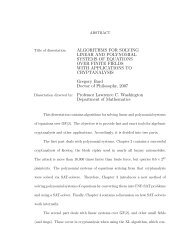Cryptography - Sage
Cryptography - Sage
Cryptography - Sage
Create successful ePaper yourself
Turn your PDF publications into a flip-book with our unique Google optimized e-Paper software.
2. We find log 7 (2) = 48 in F 89 and log 7 (2) = 94 in F 97 using the baby-step, giant-stepmethod.3. A discrete logarithm in (Z/97Z) ∗ is theoretically easier to solve because 96 = 2 5 3, sowe solve the discrete logarithms using this factorization.N.B. Verify that you can solve log 7 (2) using log 7 m(2 m ) where m = 32, and m =48, 24, 12, 6, 3, and at each of the latter steps you only need to determine one additionalbit of information.Mathematics of Shamir’s Secret Sharing SchemeRecall the Lagrange interpolation theorem:Theorem D.1 (Lagrange) Let k be a field and let f(x) be a polynomial over k of degreeless than t. Given t distinct elements x 1 , x 2 , . . . , x t of k, then f(x) equalst∑f(x i )i=1t∏j=1j≠ix − x jx i − x jExercise D.8 Let F 31 = Z/31Z be the finite field of 31 elements, and let{(1, 1), (2, 16), (3, 25), (4, 28)}be a set of pairs of the form (i, f(i)) for some polynomial f(x).1. Find the value f(0) of the polynomial f(x) of degree 2 which interpolates the firstthree points.2. Find the polynomial f(x) of degree 2 which interpolates the first three points.3. Show that the same polynomial passes through the fourth point.4. Use the Lagrange interpolation theorem to conclude that f(x) is the unique polynomialof degree less than 4 which passes through these four points.Solution.Let F 31 = Z/31Z be the finite field of 31 elements, and let{(1, 1), (2, 16), (3, 25), (4, 28)}be a set of pairs of the form (i, f(i)) for some polynomial f(x).137
















